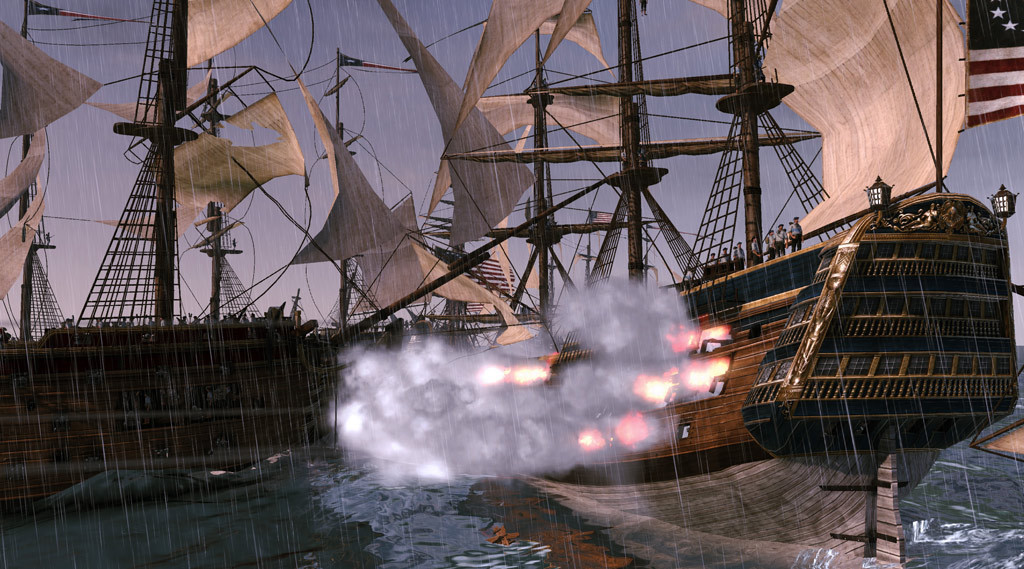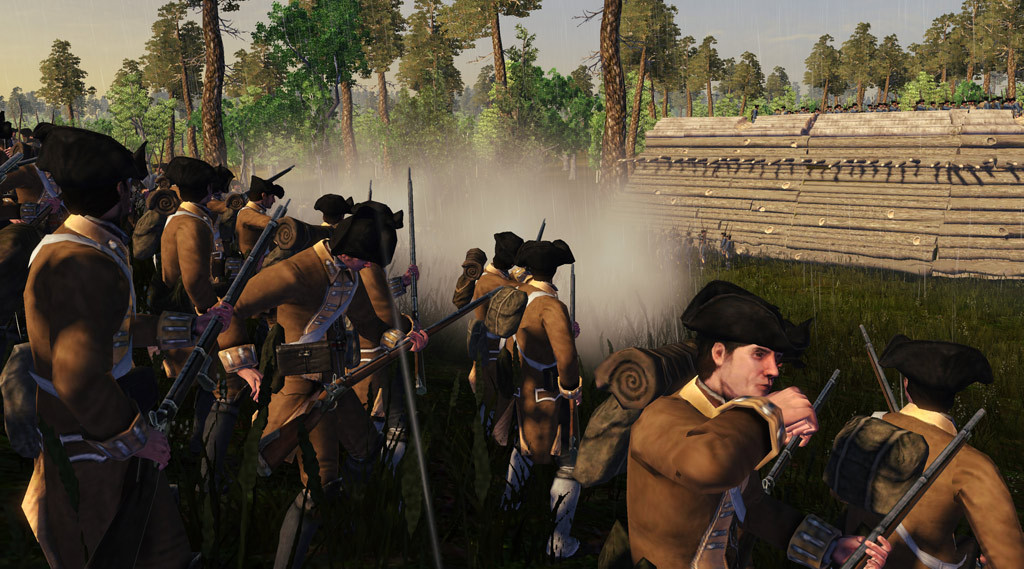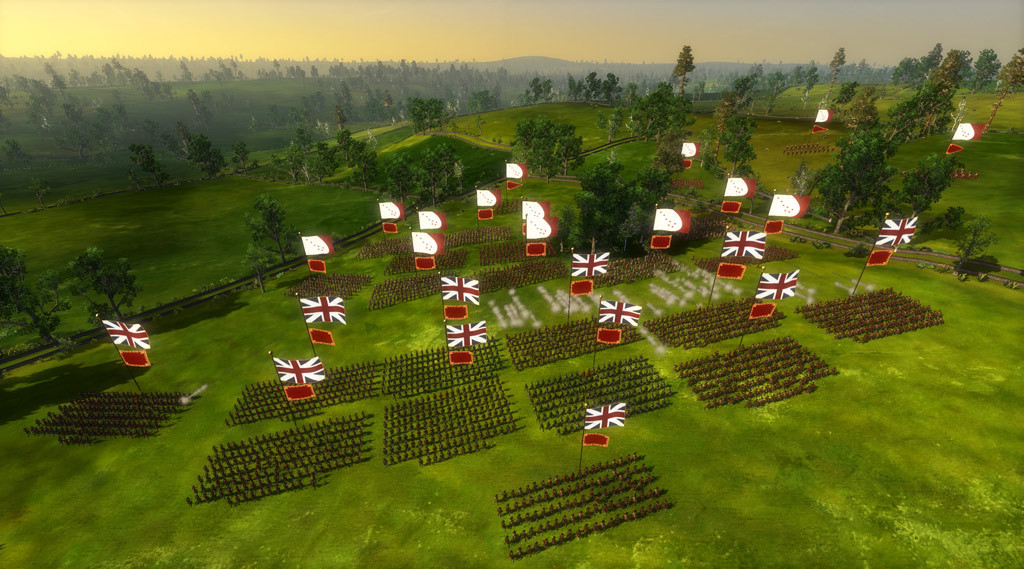
Discover Total War: EMPIRE in the Steam Summer Sale
Welcome back to the Steam Summer Sale extravaganza here on TotalWar.com. We’ve done how it all started in SHOGUN: Total War yesterday, now we’re going to one of the later points in history we’ve thus-far covered with Total War: EMPIRE. One of the most ambitious and extraordinary Total War games to date, it’s also one of our most well-received from press and players, fondly remembered for naval battles, the introduction of major amounts of ranged combat, and a very large world map.
Guy Davidson sat with us to talk about working on it all those years ago, what’s still extraordinary about it, and why you should play it today. And yes, it’s available on Steam, at 75% off: $6.24 / €6.24 / £4.99. It’s one package, the Definitive Edition, which includes all the DLC made for the game. Enjoy!
TW.com: Hi Guy, could you introduce yourself for the wonderful people of the Total War community?
Guy: My name is Guy Davidson, I’m the Head of Engineering Practice at Creative Assembly. I turn our great programmers into brilliant programmers, or at least I try and help that path along – with varying degrees of success, depending on the subject matter!
I do all sorts of things, I offer code reviews, I also run the foundation team which handles curation, and it’s also a bit of a strike team. It’s a go-to team to get stuff done. I serve on WG21, the international standards organisation/working group for C++. I also serve on the British Standards Institute as a UK expert and I’m a C++ expert in the ISO global directory. I’ve been at Creative Assembly since 1999.
At the time of EMPIRE, I was a programmer. Jerome Grasdyke was running the show, he was lead programmer. We had sub-leads or area leads and at the time I was writing tools and useful things for people. Particularly, I wrote nearly all the low-level operating system stuff – if you needed data getting off a disk and into RAM, that was my job. I tried to make that as fast as possible. I still do that and it’s still as hard as it ever was because people don’t like waiting around.
I was still helping people out. I was writing this thing called Tip of the Week where I would send out a ‘hey, don’t do that, do this’ after looking at people’s code and thinking ‘oooooohhhhhh.’ I’ve always had this role of trying to politely and kindly offer advice on better programming.
The team must have been much smaller back then.
It was tiny. I think there were, God, I can’t imagine – the programming team will only have been about 20 people, tops. I’d have to go back and look at the credits, it really was quite small. Indeed, the company itself, I think we had less than 100 employees at the time* – when I joined there were 30. ROME was written with about 20 people. Different days, different times.

What was the plan behind EMPIRE?
EMPIRE was… well, it was the game we made after ROME. We were all tired as hell after ROME. So, we thought we’d reboot the codebase and carry on with EMPIRE. MEDIEVAL II was taken on by our Brisbane office. During ROME that Australian office did all the graphics programming for us and they did a pretty good job.
Having done the graphics we said ‘why don’t you do the next title, you do MEDIEVAL II, the rest of us – we’ll go get some sleep and we’ll make EMPIRE.’ MEDIEVAL II was very much what bought us the time to make EMPIRE.
So, in EMPIRE we’re carrying on the idea of having campaign and battlefield gameplay theatres and we thought ‘yep, let’s reboot the codebase, make it all better, oh and also let’s throw in naval battles as well!’ That was the true mark of insanity, because suddenly we’d gone from making two games to making three games, and in a reduced period of time.
We had quite a long pre-production phase just for all of us to recover from the long, long development of ROME: Total War. We used that time to try and work out how we could make the game better, how we could develop the code better. Back then we had one or two designers, decent handful of good artists, but our development processes were still evolving. We were still trying to work out what the best way to do this is.
From a code point of view, we decided to divide our effort a bit more cleanly. So, we had a battle programmer, and campaign programmer, and a tools programmer. Built it all up like that. We were establishing roles and becoming a bit better at saying ‘you do this, you do this, you do this, go!’

EMPIRE’s easily one of our most well-received games in terms of review score and Steam reviews. Why do you think that is?
People forget, ROME wasn’t incredible at launch – it wasn’t until we got the second patch out that people went ‘wow, this is great.’ MEDIEVAL II was a beneficiary of that work, it was a working game to start with and they were building upon that, it had a good headstart.
EMPIRE was a big project, and it was so much bigger than anything we had done before. Not only did we add naval battles; we said – right we’ll have the whole world, we’ll have America, we’ll have the Indian sub-continent, we’ll have the entirety of Renaissance Europe. I’m surprised we didn’t throw Africa in there as well, frankly.
It was untrammeled in its vision. It was such a broad game, there were so many units, there was so much content, it was a huge step-change from MEDIEVAL II. That really did blow people away. So, it was the scale of the thing that impressed everybody – and tired us all out on the dev team as well.
Adding naval battles is probably the thing most people remember from the game – what was the goal there?
We had to have naval battles in Renaissance Europe. We couldn’t not. We had to do something. The trouble is naval battles are very, very unlike field battles. They take all day and a lot of it is just waiting around for the right wind – that’s not very exciting gameplay. At the time I remember seeing other games that allegedly featured naval battles and basically you have ships going in a straight line and then turning a corner, which isn’t how ships work. They were basically land battles at sea using ship models instead of platoon models. Naval battles are subtle beasts that require patience and it’s hard to meld that around a game experience.
We didn’t think it would be a huge problem. We’d do the research, we’d find out what we needed, we had designers, they’d tell us how naval battles worked. Once that was done we ended up at ‘where’s the game, where’s the fun?’ Plus, we had to make the sea! Rendering the sea is not a trivial undertaking. Not even slightly.

There’s a note on Wikipedia that one guy just spent a whole year working on the water.
Scott Pitkethly, now our technical director on WARHAMMER. The trouble was, whenever you try to draw the sea, people say ‘oh, that doesn’t look very realistic.’ So, you say ‘well, describe the sea’ – and the sea is eternally changing. There is not a typical sea.
Sea changes according to depth, latitude, time of day, temperature, marine population, you know – there’s even a spot on the Earth where two oceans meet and it’s a hard, obvious line.** The sea is very hard to model and to draw.
But that turned out to be the least of our problems when modelling naval warfare. Modelling sails and flags, actual fabric, is pretty hard, let alone wind and how ships move about. What you want in a naval battle is you want the bit where one ship sails past another and empties its cannons into it and then it explodes because you hit the powder magazine. It sinks into the water, and everybody jumps off and it’s all very Master & Commander.
Two or three times in your entire life as a sailor would that sort of thing happen. It’s like putting Stonehenge on every battlefield – there’s one Stonehenge, and it’s only over there. Naval battles were hard because it was hard to make them a good game.
We went and talked to Scott about his work on EMPIRE and the water physics – here’s his account.
Scott: Yeah, I worked on the sea, amongst many other things on EMPIRE. I think the comment that I spent a year on it may well be apocryphal, haha. After ROME we had some downtime where we didn’t know exactly what we were doing next, so the prototype was developed during that time. I am still pleased with that system though, and we carried on using it for many projects afterwards. I can give you a rough outline of how it worked:
- It was based on a graphics paper, Simulating Ocean Water by Jerry Tessendorf.
- It used frequencies from the Phillips spectrum to represent waveforms found in deep water, which were then physically animated in frequency space using Fourier Transforms. This was done offline and stored in a big animation as we didn’t have the processing power to simulate it in real-time.
- We modelled different sea surfaces for different wind strengths – for the higher winds we added ‘chop’ to the waves by dynamically pushing the vertices towards the crest of the waves.
- I wrote a system of foam propagation, so that these wave crests would generate foam which was projected onto the surface of the sea and expanded in size over time.
- We used this same waveform data to animate the ships floating on the sea, which we modelled with floating spheres called Bobbies. A ship would have many of these Bobbies linked together, and they would ‘bob’ up and down on the water surface in a physically correct manner. They could also fill up with water as cannonballs hit the ship, causing the ship to sink realistically based on where the impact occurred.
- We had nice physics using Vertlet Integration on the ships rigging and sails which flapped around in the wind. You could also blow holes in the sails.
Thanks Scott! We’ll probably dive a bit deeper on some of those topics at some point on the website, if people are interested. Back to Guy…

Do you think you rode the right line between historical accuracy and fun gameplay in the end?
Guy: I really don’t know how to answer that question to be honest. We want to make historical games. With Warhammer we’re off the leash somewhat but making historical titles… We can’t just take the mickey all the time. We can’t just say this is a historico-fictional simulation of this period without the realism of it.
The trouble with that is it’s in the eye of the beholder. I might think ‘yep, that’s pretty good’ but somebody who spent a large part of their lives studying British naval warfare mechanisms in the 19th century or has served in the Navy – they might look at it and go ‘nah, not really.’
If we give you infinite budget and resources, plus a time machine, what would you change?
Actually just fixing it. It was pretty buggy when it came out. We’re victims of our own ambition. If we’d just delayed it a little bit, fixed more stuff, put the feature lock on a bit earlier… People did eventually notice. After a couple of weeks of playing we did get some quite perceptive reviews that saw it could have done with a bit more time.
Are you proud of it, as a game?
Yes. God, yes. All our games, I’m immensely proud of all our work, I always am. The thing with EMPIRE is it was such a comeback after ROME – MEDIEVAL II, another studio did that. Having done ROME and thought ‘right, what shall we do next – EMPIRE, bang.’

What sticks out as something that’s still going to impress people today?
First of all: the music. The music was lovely, really. Just putting it on and listening to it, it was marvellous, I loved it. Second, the world was tremendously realised. The detail was profound. You can just slowly scroll around the map and look at cities and read descriptions. The detail is what will grab people, there’s so much to get your teeth into, there’s so many styles of battle and warfare.
Thanks for your thoughts Guy – we’ll definitely have you back on for further discussions in the future.
That’s all for EMPIRE today. More to come on our back catalogue of excellent Total War games in the next few days. Let us know via our social channels what games you want to hear more about!
*Creative Assembly is now a company of 800 across two countries and four studios.
**This, believe it or not, is in the Gulf of Alaska and pictures of it are quite extraordinary.